► Ford’s hybrid WRC
► It *looks* like a Puma
► 100kW motor for performance
Ford’s bold new hybrid world rally car has been revealed, and now we get to see its new, official livery. The car was revealed in testing livery at the Goodwood Festival of Speed – and there CAR experienced it first-hand from the passenger seat. Read on for our driving impressions.
The new Puma Hybrid will compete in the FIA World Rally Championship from 2022, under its new Rally1 regulations formula mandating plug-in hybrid powertrains and sustainable fuels.
Engineered in conjunction with British motorsport engineering firm M-Sport, the Puma WRC cars will be built at M-Sport’s Cumbria base. The car will debut at Monte Carlo Rally, between January 20-23rd.
So Ford’s new World Rally car is a Puma, not a Fiesta?
The Fiesta has carried the Blue Oval’s hopes on the World Rally stage(s) since 2011 but as markets shift to crossovers, Ford has chosen the Puma as the model to benefit from the WRC’s marketing power in the new Rally1 era.
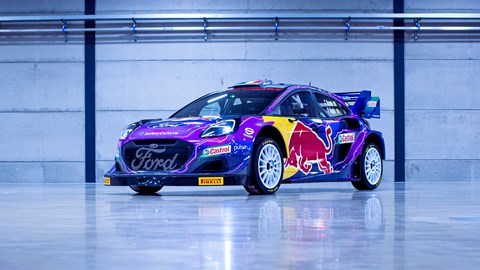
The new car doesn’t share much in common with the Puma road car, however. The new Rally1 rules mean that, for the first time, very few parts of the bodyshell need to be shared with the production car. Only the bonnet, windscreen, tailgate and roofskin need to be carried over, allowing a great deal of freedom with the car’s structure and aerodynamics.
‘The biggest thing [for this project] is that we’re not using a production-based bodyshell,’ says M-Sport director (and former professional rally driver) Malcolm Wilson. ‘We’re usually starting with cutting sheet metal. It’s exciting.’
Part of the reason for moving away from production-based bodyshells is to enable greater safety for the driver and co-driver: the seats have been moved inwards and there is extra protection built into the cockpit’s structure to protect against side impacts.
‘The FIA has taken a great deal of data from the current WRC cars and an invaluable amount of research has gone into the safety standards,’ Wilson adds.
What’s powering the new Ford Puma Hybrid WRC car?
The 1.6-litre turbocharged engine is carried over from the existing Fiesta WRC car, a move by the FIA to mitigate costs for the manufacturers given the extra costs involved in developing the new-generation hybrid WRC cars.
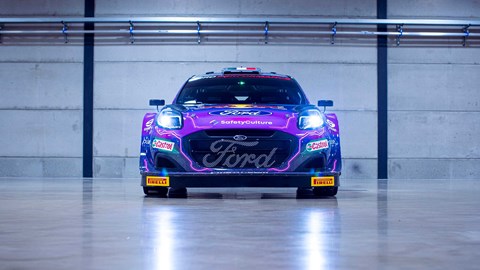
It’s joined by a 100kW motor, fed by a 3.9kWh battery. Energy regenerated from braking and coasting charges the battery, and it can also be plugged into a 25-minute fast-charger in service areas.
Rather than a fuel-saving measure, the motor is used primarily for a performance boost in the Puma. The delay for the motor’s e-boost is less than that of any turbo boost.
The car can run in a zero emissions electric mode too – the team may discuss with the FIA governing body when that mode will be deployed, on the road or in service areas, for example. The battery doesn’t have the capability to run in pure EV mode for the entirety of a road section at present.
Looks like there’s some serious aero going on…
The project began in late 2019, and M-Sport has been working together with Ford Performance’s engineers in the USA. Its windtunnel in Charlotte has been invaluable, Wilson says:
‘We’ve been able to use Ford’s moving-floor tunnel. We can put the car in yaw, we can simulate jumping it – it’s a powerful tool.’
This isn’t M-Sport’s first EV motorsport project, having previously created Jaguar’s i-Pace eTrophy racing cars. ‘We learned a lot about the operational side and safety too with that project,’ Wilson says.
Wilson says that the Rally1 regulations are the biggest technical reset rallying’s top tier has seen in decades.
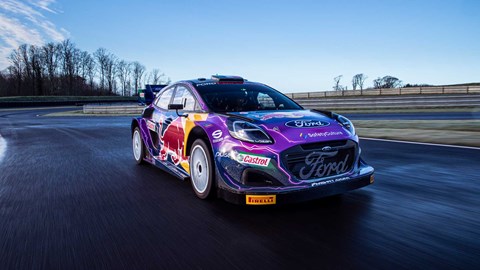
‘I’m excited about it. Not just the performance but the whole chassis – the way the thing reacts out of the slow corners. It’s probably the first car I’ve seen doing that where I’ve thought – I’ll leave this to the professional drivers!
‘The driver who gets the most out of the hybrid system may do the best. It will be a smart driver who will use the system the best – 5km into the first stage at Monte Carlo, they’ll be making some key decisions… The regulations also mean we’re now using a manual gearbox, so if they miss a gear, that will be crucial.’
CAR rides in the Puma at Goodwood
CAR clambers aboard the Ford Puma Hybrid WRC prototype for a passenger ride up Goodwood Hill on the Sunday at the Festival of Speed, with lead development driver Matthew Wilson at the wheel.
If you’re a tall co-driver, you might be a bit cramped – the firewall has come back into the cabin a little more. There’s also an extra rollcage bar to squeeze past to get into the cabin, part of the new measures to better protect occupants in a side impact. You’re also sat more inboard, closer to the driver, than in previous WRC cars.
The structure above and below you is more akin to a tubular spaceframe chassis than previous WRC cars, with lots of triangulated sections for strength above the floor and below the roofskin.
Away from the assembly area with a pull of the new manual sequential gearbox lever, and Wilson aggressively warms the tarmac-spec tyres on the run to the startline. The braking also has the benefit of making sure the battery is fully charged to make best use of the battery’s boost up the hill.
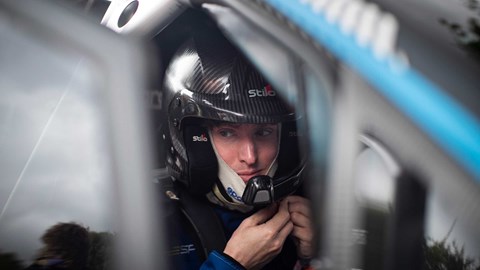
A neat handbrake turn to line up for the startline and a combination of button presses on the wheel to enable launch control. Revs up, brakes released and we’re away, fast.
What follows is a neat, tidy and impressively undramatic run up Goodwood Hill. Two bites at the steering into the first corner to check the grip levels on this greasy track, still drying from morning rain – there’s plenty, the Puma’s front tyres chomping into the tarmac and instantly finding the apex. There’s huge traction on the way out of the corners too, even with the extra 100bhp+ shot of power from the electric motor deployed.
Currently the hybrid boost is activated by the last bit of travel of the throttle pedal. Later it may be a two-stage pedal akin to an auto road car’s kickdown, or activated another way. ‘The idea’s still up for discussion – how many maps there’ll be, and how the team develops them,’ says M-Sport’s Richard Milliner. For slippery or icy conditions, for example, it may be that the driver can adjust the amount of hybrid boost.
While it’s undramatic here at smooth-surfaced Goodwood, where the Puma WRC simply grips and goes, when the boost heaves in on slippery mud it’s a little bit more wild, Matthew says…
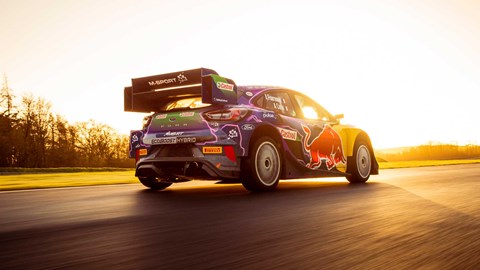
The traction the Puma finds is impressive, especially as the new Rally1 regs forbid active centre differntials and mandate mechanical diffs at each end rather than electronic units.
It’s great to see Wilson grabbing gears on the tall sequential shift lever like rally drivers of old, too.
Down in the centre console near the floor, there’s a screen readout with all kinds of complex information regarding the battery charge and boost availability for the cramped co-driver to keep an eye on. They’re going to be busy.
And it’ll only get faster between now and the 2022 season kick-off…
Later in the Festival, the Puma Rally1 raced to 13th position overall against all-comers in Goodwood’s final shootout. And there’s more to come. This is prototype number one of one so far. The next validation prototype will be even more sophisticated, and will weigh ‘150 to 180kg less than this car,’ Malcolm Wilson says.
When the season-opening Monte Carlo rally rolls around in January 2022, the car will have been considerably developed.
This prototype has covered around 1900 miles so far, and has run in anger before prototypes from Ford’s rivals Hyundai and Toyota. ‘We’ve been the first people to run, and that’s been crucial for us – we’ve learnt a lot early on especially with the hybrid system,’ Malcolm Wilson says.
Each manufacturer team is likely to run three cars. Ford’s drivers are yet to be confirmed, other than rising French star Adrien Fourmaux. His Hyundai opponents will compete in a car based on the i20N, and Toyota is expected to field a new iteration of the Yaris WRC.